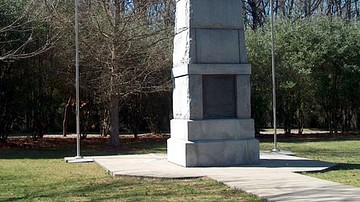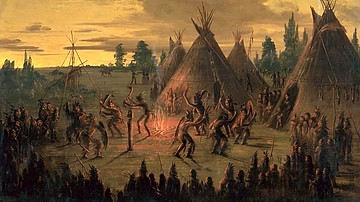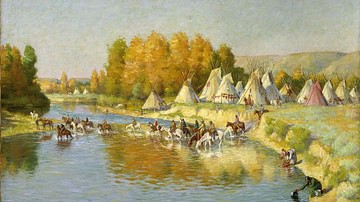Tsul'kălû', The Slant-Eyed Giant is a myth of the Cherokee nation and is among the most popular. The legend relates the story of the great giant, Tsul'kălû', his marriage to a Cherokee maiden, and how the people broke trust with him so that, ever after, he could not be seen, though his presence and power could be felt.
The giant's name, Tsul'kălû', means "he has them slanting", referring to his eyes. He is said to inhabit the top of the Tanasee Bald Mountain in modern-day North Carolina in his home, known as Tsunegûñ′yĭ. He is the Great Lord of the Game, the spirit invoked prior to and during a hunt, and he is said to assist hunters in tracking their quarry. As a spirit, the giant is invisible, and this is hardly unusual as Native American lore generally, and Cherokee tales specifically, abound with unseen spirits, but this tale explains how Tsul'kălû' came to be invisible and why the people never have, and never will, see him.
In the story, the young woman and her mother live in the village of Kanuga ("gathering place"), roughly, modern-day Hendersonville, North Carolina. The mother lives in the family lodge while her daughter lives in the asi – a wattle and daub house, often referred to as a "winter house", which is sometimes, though not always, smaller and more compact than a lodge. The asi of the Cherokee, historically, had no windows and a hearth in the center, and so it was always smoky and dark. Setting part of the story in an asi lends a comedic aspect to some parts of the tale, as the structure was not big enough to accommodate a giant, much less the giant and his wife, which would have been appreciated by the original audience.
This story – like the Cherokee legend of The Man Who Married the Thunder Sister, the Cherokee Ulunsuti tales, the Wihio tales of the Cheyenne, and the Iktomi tales of the Sioux – emphasizes the importance of paying attention to and following instructions. This concept appears frequently in Native American literature where supernatural entities bestow gifts on those who follow instruction, even if they do not understand the reason, and punish those who cannot do so. Frequently, the transgressor actually punishes himself or herself by failing to simply do as they were told.
Following instructions is a central cultural value of the Native peoples of North America generally, as it has to do with the observance of traditions, rites, and rituals, which need to be performed in a certain way, as they always have been, without deviation or innovation. In the following story, failure to follow instructions results in gifts withheld and the giant rendering himself invisible for all time.
Text
The following text comes from Myths of the Cherokee (1900) by James Mooney, republished by Dover Publications, 2014.
A long time ago a widow lived with her one daughter at the old town of Kănuga on Pigeon River. The girl was of age to marry, and her mother used to talk with her a good deal and tell her she must be sure to take no one but a good hunter for a husband, so that they would have someone to take care of them and would always have plenty of meat in the house. The girl said such a man was hard to find, but her mother advised her not to be in a hurry, and to wait until the right one came.
Now the mother slept in the house while the girl slept outside in the âsĭ. One dark night a stranger came to the âsĭ wanting to court the girl, but she told him her mother would let her marry no one but a good hunter. "Well," said the stranger, "I am a great hunter," so she let him come in, and he stayed all night. Just before day he said he must go back now to his own place, but that he had brought some meat for her mother, and she would find it outside. Then he went away, and the girl had not seen him. When day came, she went out and found there a deer, which she brought into the house to her mother, and told her it was a present from her new sweetheart. Her mother was pleased, and they had deer steaks for breakfast.
He came again the next night, but again went away before daylight, and this time he left two deer outside. The mother was more pleased this time, but said to her daughter, "I wish your sweetheart would bring us some wood." Now wherever he might be, the stranger knew their thoughts, so when he came the next time he said to the girl, "Tell your mother I have brought the wood"; and when she looked out in the morning there were several great trees lying in front of the door, roots and branches and all. The old woman was angry, and said, "He might have brought us some wood that we could use instead of whole trees that we can't split, to litter up the road with brush." The hunter knew what she said, and the next time he came he brought nothing, and when they looked out in the morning the trees were gone and there was no wood at all, so the old woman had to go after some herself.
Almost every night he came to see the girl, and each time he brought a deer or some other game, but still he always left before daylight. At last, her mother said to her, "Your husband always leaves before daylight. Why don't he wait? I want to see what kind of a son-in-law I have." When the girl told this to her husband, he said he could not let the old woman see him, because the sight would frighten her. "She wants to see you, anyhow," said the girl, and began to cry, until at last he had to consent, but warned her that her mother must not say that he looked frightful (usga′sĕʻti′yu).
The next morning, he did not leave so early, but stayed in the âsĭ, and when it was daylight, the girl went out and told her mother. The old woman came and looked in, and there she saw a great giant, with long slanting eyes (tsulʻkălû′), lying doubled up on the floor, with his head against the rafters in the left-hand corner at the back, and his toes scraping the roof in the right-hand corner by the door. She gave only one look and ran back to the house, crying, Usga′sĕʻti′yu! Usga′sĕʻti′yu!
Tsulʻkălû′ was terribly angry. He untwisted himself and came out of the âsĭ, and said good-bye to the girl, telling her that he would never let her mother see him again, but would go back to his own country. Then he went off in the direction of Tsunegûñ′yĭ.
Soon after he left the girl had her monthly period. There was a very great flow of blood, and the mother threw it all into the river. One night after the girl had gone to bed in the âsĭ her husband came again to the door and said to her, "It seems you are alone," and asked where was the child. She said there had been none. Then he asked where was the blood, and she said that her mother had thrown it into the river. She told just where the place was, and he went there and found a small worm in the water. He took it up and carried it back to the âsĭ, and as he walked it took form and began to grow, until, when he reached the âsĭ, it was a baby girl that he was carrying. He gave it to his wife and said, "Your mother does not like me and abuses our child, so come and let us go to my home." The girl wanted to be with her husband, so, after telling her mother good-bye, she took up the child and they went off together to Tsunegûñ′yĭ.
Now, the girl had an older brother, who lived with his own wife in another settlement, and when he heard that his sister was married, he came to pay a visit to her and her new husband, but when he arrived at Kănuga his mother told him his sister had taken her child and gone away with her husband, nobody knew where. He was sorry to see his mother so lonely, so he said he would go after his sister and try to find her and bring her back. It was easy to follow the footprints of the giant, and the young man went along the trail until he came to a place where they had rested, and there were tracks on the ground where a child had been lying and other marks as if a baby had been born there. He went on along the trail and came to another place where they had rested, and there were tracks of a baby crawling about and another lying on the ground. He went on and came to where they had rested again, and there were tracks of a child walking and another crawling about. He went on until he came where they had rested again, and there were tracks of one child running and another walking. Still, he followed the trail along the stream into the mountains and came to the place where they had rested again, and this time there were footprints of two children running all about, and the footprints can still be seen in the rock at that place.
Twice again he found where they had rested, and then the trail led up the slope of Tsunegûñ′yĭ, and he heard the sound of a drum and voices, as if people were dancing inside the mountain. Soon he came to a cave like a doorway in the side of the mountain, but the rock was so steep and smooth that he could not climb up to it but could only just look over the edge and see the heads and shoulders of a great many people dancing inside. He saw his sister dancing among them and called to her to come out. She turned when she heard his voice, and as soon as the drumming stopped for a while, she came out to him, finding no trouble to climb down the rock, and leading her two little children by the hand. She was very glad to meet her brother and talked with him a long time, but did not ask him to come inside, and at last he went away without having seen her husband.
Several other times her brother came to the mountain, but always his sister met him outside, and he could never see her husband. After four years had passed, she came one day to her mother's house and said her husband had been hunting in the woods nearby, and they were getting ready to start home to-morrow, and if her mother and brother would come early in the morning, they could see her husband. If they came too late for that, she said, they would find plenty of meat to take home. She went back into the woods, and the mother ran to tell her son. They came to the place early the next morning, but Tsulʻkălû′ and his family were already gone. On the drying poles they found the bodies of freshly killed deer hanging, as the girl had promised, and there were so many that they went back and told all their friends to come for them, and there were enough for the whole settlement.
Still the brother wanted to see his sister and her husband, so he went again to the mountain, and she came out to meet him. He asked to see her husband, and this time she told him to come inside with her. They went in as through a doorway, and inside he found it like a great townhouse. They seemed to be alone, but his sister called aloud, "He wants to see you," and from the air came a voice, "You cannot see me until you put on a new dress, and then you can see me." "I am willing," said the young man, speaking to the unseen spirit, and from the air came the voice again, "Go back, then, and tell your people that to see me they must go into the townhouse and fast seven days, and in all that time they must not come out from the townhouse or raise the war whoop, and on the seventh day I shall come with new dresses for you to put on so that you can all see me."
The young man went back to Kănuga and told the people. They all wanted to see Tsulʻkălû′, who owned all the game in the mountains, so they went into the townhouse and began the fast. They fasted the first day and the second and every day until the seventh—all but one man from another settlement, who slipped out every night when it was dark to get something to eat and slipped in again when no one was watching. On the morning of the seventh day the sun was just coming up in the east when they heard a great noise like the thunder of rocks rolling down the side of Tsunegûñ′yĭ. They were frightened and drew near together in the townhouse, and no one whispered. Nearer and louder came the sound until it grew into an awful roar, and everyone trembled and held his breath—all but one man, the stranger from the other settlement, who lost his senses from fear and ran out of the townhouse and shouted the war cry.
At once the roar stopped and for some time there was silence. Then they heard it again, but as if it were going farther away, and then farther and farther, until at last it died away in the direction of Tsunegûñ′yĭ, and then all was still again. The people came out from the townhouse, but there was silence, and they could see nothing but what had been seven days before.
Still the brother was not disheartened, but came again to see his sister, and she brought him into the mountain. He asked why Tsulʻkâlû′ had not brought the new dresses, as he had promised, and the voice from the air said, "I came with them, but you did not obey my word, but broke the fast and raised the war cry." The young man answered, "It was not done by our people, but by a stranger. If you will come again, we will surely do as you say." But the voice answered, "Now you can never see me." Then the young man could not say any more, and he went back to Kănuga.






